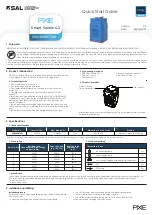
NOTE: A network management system (NMS) should be ready to interpret a down interface and
plot the interface performance graph accordingly.
•
Line Card Down — The
same as Interface Down (see previous).
•
RPM Down
,
RPM Failover
— Master and standby route processor modules (RPMs) run the RMON
sampling process in the background. Therefore, when an RPM goes down, the other RPM maintains
the sampled data — the new master RPM provides the same sampled data as did the old master — as
long as the master RPM had been running long enough to sample all the data. NMS backs up all the
long-term data collection and displays the failover downtime from the performance graph.
•
Chassis Down
— When a chassis goes down, all sampled data is lost. But the RMON configurations
are saved in the configuration file. The sampling process continues after the chassis returns to
operation.
•
Platform Adaptation
— RMON supports all Dell Networking chassis and all Dell Networking Ethernet
interfaces.
Setting the rmon Alarm
To set an alarm on any MIB object, use the
rmon alarm
or
rmon hc-alarm
command in GLOBAL
CONFIGURATION mode.
• Set an alarm on any MIB object.
CONFIGURATION mode
[no] rmon alarm
number variable interval
{delta | absolute} rising-threshold
[
value event-number
] falling-threshold
value event-number
[owner
string
]
OR
[no] rmon hc-alarm
number variable interval
{delta | absolute} rising-
threshold
value event-number
falling-threshold
value event-number
[owner
string
]
Configure the alarm using the following optional parameters:
–
number
: alarm number, an integer from 1 to 65,535, the value must be unique in the RMON Alarm
Table.
–
variable
: the MIB object to monitor — the variable must be in SNMP OID format; for example,
1.3.6.1.2.1.1.3. The object type must be a 32-bit integer for the
rmon alarm
command and 64 bits
for the
rmon hc-alarm
command.
–
interval
: time in seconds the alarm monitors the MIB variable, the value must be between 1 to
3,600.
–
delta
: tests the change between MIB variables, this option is the alarmSampleType in the RMON
Alarm table.
–
absolute
: tests each MIB variable directly, this option is the alarmSampleType in the RMON Alarm
table.
–
rising-threshold
value
: value at which the rising-threshold alarm is triggered or reset. For
the
rmon alarm
command, this setting is a 32-bits value, for the
rmon hc-alarm
command, this
setting is a 64-bits value.
–
event-number
: event number to trigger when the rising threshold exceeds its limit. This value is
identical to the alarmRisingEventIndex in the alarmTable of the RMON MIB. If there is no
corresponding rising-threshold event, the value should be zero.
–
falling-threshold
value
: value at which the falling-threshold alarm is triggered or reset. For
the
rmon alarm
command, this setting is a 32-bits value, for the
rmon hc-alarm
command this
setting is a 64 bits value.
840
Remote Monitoring (RMON)
Summary of Contents for S4820T
Page 1: ...Dell Configuration Guide for the S4820T System 9 8 0 0 ...
Page 282: ...Dell 282 Control Plane Policing CoPP ...
Page 622: ...Figure 81 Configuring Interfaces for MSDP 622 Multicast Source Discovery Protocol MSDP ...
Page 623: ...Figure 82 Configuring OSPF and BGP for MSDP Multicast Source Discovery Protocol MSDP 623 ...
Page 629: ...Figure 86 MSDP Default Peer Scenario 2 Multicast Source Discovery Protocol MSDP 629 ...
Page 630: ...Figure 87 MSDP Default Peer Scenario 3 630 Multicast Source Discovery Protocol MSDP ...
Page 751: ...10 11 5 2 00 00 05 00 02 04 Member Ports Te 1 2 1 PIM Source Specific Mode PIM SSM 751 ...
Page 905: ...Figure 112 Single and Double Tag First byte TPID Match Service Provider Bridging 905 ...
Page 979: ...6 Member not present 7 Member not present Stacking 979 ...
Page 981: ...storm control Storm Control 981 ...
Page 1103: ...Figure 134 Setup OSPF and Static Routes Virtual Routing and Forwarding VRF 1103 ...
















































